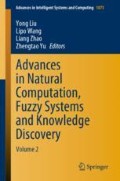Abstract
Feature extraction and matching recognition are two critical stages in face recognition process. While traditional Bayesian classifier exists the small sample problem in the matching recognition stage, a novel Bayesian face recognition approach based on feature fusion is proposed. In the feature extraction stage, the global non-linear feature is extracted by kernel principal component analysis (KPCA), and the local manifold structure information is extracted by the orthogonal locality sensitive discriminant analysis (OLSDA), achieving the purpose of extracting the low-dimension essential facial feature with high-discrimination, and the constraints of the fusion features make the obtained matrix be closer to the desired solution. In the matching recognition stage, a maximum entropy covariance selection (MECS) method is utilized to solve the small sample problem. Extensive experimental results on several datasets show that these two stages can significantly improve the accuracy of face recognition.
Access this chapter
Tax calculation will be finalised at checkout
Purchases are for personal use only
References
Zhou, X., Sánchez, S.A., Kuijper, A.: 3D face recognition with local binary patterns. In: 2010 Sixth International Conference on Intelligent Information Hiding and Multimedia Signal Processing (2010)
Lai, Z., Xu, Y., Chen, Q., Yang, J., Zhang, D.: Multilinear sparse principal component analysis. IEEE Trans. Neural Netw. Learn. Syst. 25(10), 1942–1950 (2014)
Triggs, N.D.: Histograms of oriented gradients for human detection. In: 2005 IEEE Computer Society Conference on Computer Vision (2005)
Saika, S., Takahashi, S., Takeuchi, M., Katto, J.: Accuracy improvement in human detection using HOG features on train-mounted camera. In: 2016 IEEE Global Conference on Consumer Electronics (2016)
Felzenszwalb, P.F., Mcallester, D.A., Ramanan, D.: A discriminatively trained, multiscale, deformable part model. In: 2008 IEEE Conference on Computer Vision and Pattern Recognition (CVPR) (2008)
Lee, J.M., Yoo, C.K., Choi, S.W., Vanrolleghem, P.A., Lee, I.B.: Nonlinear process monitoring using kernel principal component analysis. Chem. Eng. Sci. 59(1), 223–234 (2004)
Hou, C., Nie, F., Yi, D., Tao, D.: Discriminative embedded clustering: a framework for grouping high-dimensional data. IEEE Trans. Neural Netw. Learn. Syst. 26(6), 1287–1299 (2017)
Carli, F.P., Ferrante, A., Pavon, M., Picci, G.: A maximum entropy solution of the covariance extension problem for reciprocal processes. IEEE Trans. Autom. Control 56(9), 1999–2012 (2011)
Kim, K.I., Franz, M.O., Scholkopf, B.: Iterative kernel principal component analysis for image modeling. IEEE Trans. Pattern Anal. Mach. Intell. 27(9), 1351–1366 (2005)
Yi, J., Ruan, Q.: Orthogonal locality sensitive discriminant analysis for face recognition. In: 2014 International Conference on Signal Processing (2014)
Driessen, B., Dürmuth, M.: Achieving anonymity against major face recognition algorithms. In: 2013 IFIP International Conference on Communications and Multimedia Security (2013)
Molaei, A.M., Ebrahimzadeh, A.: Optimal steganography with blind detection based on Bayesian optimization algorithm. Pattern Anal. Appl. 22(1), 205–219 (2019)
Acknowledgments
This work was partially supported by the National Natural Science Foundation of China with Grant Nos. (61525401, 61234002, 51705304), Natural Science Foundation of Shanghai with Grant Nos. (19ZR1420800, 16ZR1413400), the Program of Shanghai Academic/Technology Research Leader with Grant No. 16XD1400300, the Major Scientific and Technological Innovation Projects of Shanghai Education Commission with Grant No. 2017-01-07-00-07-E00026.
Author information
Authors and Affiliations
Corresponding authors
Editor information
Editors and Affiliations
Rights and permissions
Copyright information
© 2020 Springer Nature Switzerland AG
About this paper
Cite this paper
Liu, J. et al. (2020). Bayesian Face Recognition Approach Based on Feature Fusion. In: Liu, Y., Wang, L., Zhao, L., Yu, Z. (eds) Advances in Natural Computation, Fuzzy Systems and Knowledge Discovery. ICNC-FSKD 2019. Advances in Intelligent Systems and Computing, vol 1075. Springer, Cham. https://doi.org/10.1007/978-3-030-32591-6_4
Download citation
DOI: https://doi.org/10.1007/978-3-030-32591-6_4
Published:
Publisher Name: Springer, Cham
Print ISBN: 978-3-030-32590-9
Online ISBN: 978-3-030-32591-6
eBook Packages: Intelligent Technologies and RoboticsIntelligent Technologies and Robotics (R0)

